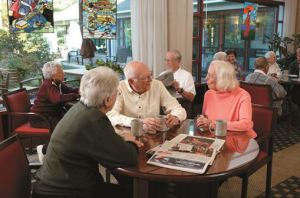
Every May, the Administration on Aging—part of the Administration for Community Living—leads the nation’s observance of Older American’s Month. For 2018,
the theme will be “Engage at Every Age,” which emphasizes that you are never too old to take part in activities that can enrich your physical, mental and emotional well-being and celebrates the many ways older adults make a difference in our communities.
Participating in activities that promote mental and physical wellness, offering your wisdom and experience to the next generation, or seeking the mentorship of someone with more life experience than you are just a few examples of being engaged. Volunteering at your favorite non-profit organization also provides meaningful engagement that simultaneously positively impacts the community.


 Plan ahead. Have a visit with the calendar to see what’s ahead. Fill in the dates and times for all of the events ahead—both family time and work time if it applies. Then, think about all of these activities. Are they really essential to your holiday bliss, or would there be more bliss if some were moved or eliminated? Can you really handle everything on that calendar, or is it too much?
Plan ahead. Have a visit with the calendar to see what’s ahead. Fill in the dates and times for all of the events ahead—both family time and work time if it applies. Then, think about all of these activities. Are they really essential to your holiday bliss, or would there be more bliss if some were moved or eliminated? Can you really handle everything on that calendar, or is it too much? A few years ago, I eliminated a live Christmas tree, which seemed to me the essence of Christmas. It was hard, but it was the right decision. We bought a scrappy-looking little artificial tree and no longer had to coordinate with someone to help get the tree home and set up. Now, whoever comes home for Thanksgiving gets the tree down from the attic and sets it up. Together we all decorate. Decorating the tree has become a nice family activity and that is where we now invest the time and energy.
A few years ago, I eliminated a live Christmas tree, which seemed to me the essence of Christmas. It was hard, but it was the right decision. We bought a scrappy-looking little artificial tree and no longer had to coordinate with someone to help get the tree home and set up. Now, whoever comes home for Thanksgiving gets the tree down from the attic and sets it up. Together we all decorate. Decorating the tree has become a nice family activity and that is where we now invest the time and energy.





 The fall months are traditionally thought of as back to school time. Just saying that phrase, “back to school,” evokes a ton of special memories—new clothes, new school supplies, and new things to learn.
The fall months are traditionally thought of as back to school time. Just saying that phrase, “back to school,” evokes a ton of special memories—new clothes, new school supplies, and new things to learn.

